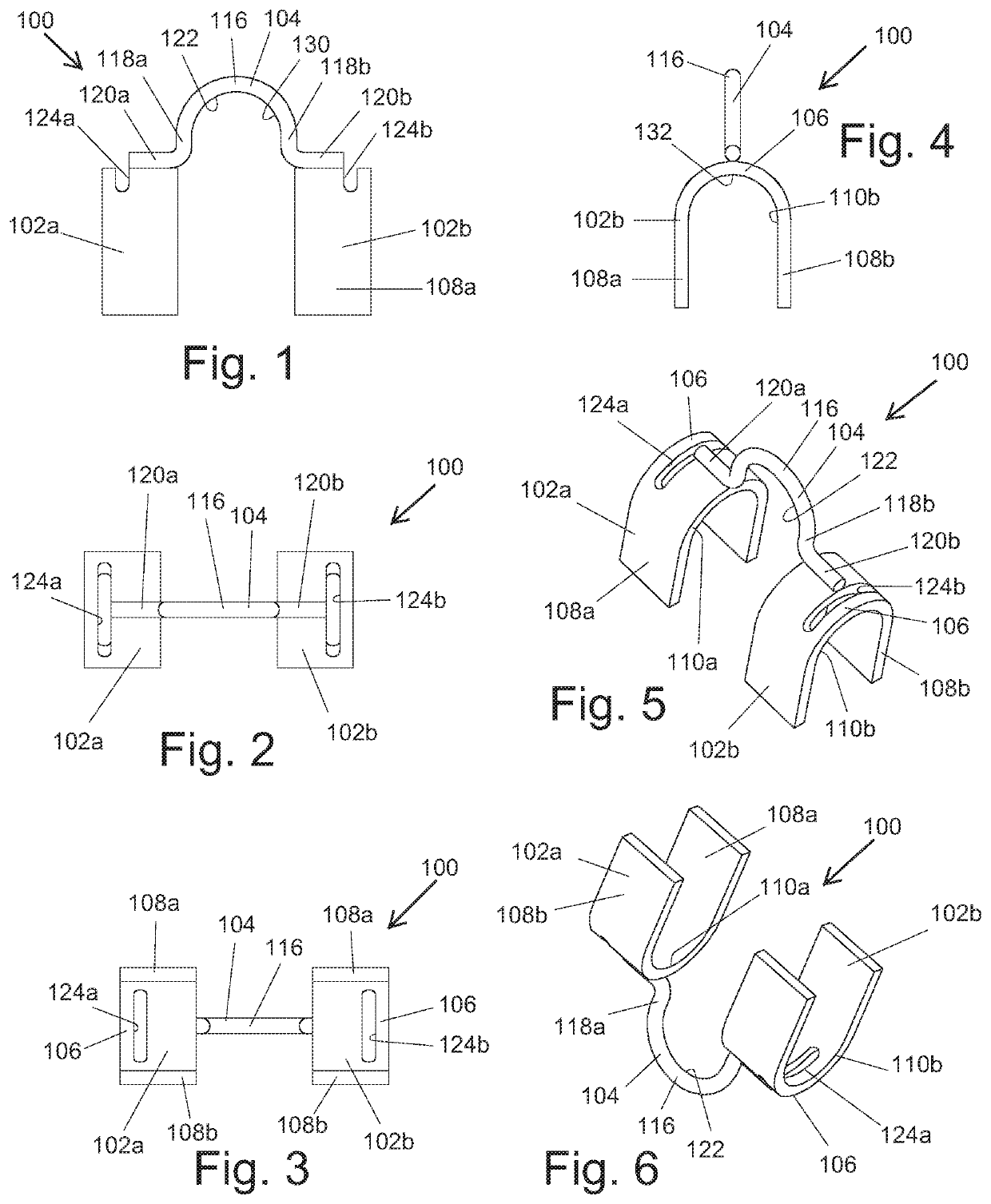Collated rebar clinch clip
a technology of collapsing rebar and clinch, which is applied in the field of collapsing rebar clinch clips, can solve the problems of poor tension, costly and backbreaking operation, and the manufacture of such clips does not lend itself to efficient configuration, so as to achieve tight connection, less cost, and tighter connection
- Summary
- Abstract
- Description
- Claims
- Application Information
AI Technical Summary
Benefits of technology
Problems solved by technology
Method used
Image
Examples
first embodiment
[0064]In FIGS. 1-18, a collated rebar clinch clip, generally designated 100, for fixing two lengths of rebar together is shown. As best seen in FIGS. 13-18, the clip 100 is positioned over two lengths rebar, a longitudinally-extending upper rebar 150 and an underlying laterally-extending lower rebar 152 orthogonal to and abutting the bottom of the upper rebar 150.
[0065]As seen in FIGS. 1-6, an individual clip 100, which may be made of low carbon steel, has three components, namely, a pair of crimp elements 102a,102b and an arched bridge element 104, connecting the crimp elements 102a,102b that are located below in laterally spaced relation.
[0066]Each of the crimp elements 102a,102b is a U-shaped strip having a center bight portion 106 and a pair of parallel downwardly-extending legs 108a,108b. The legs 108a,108b of the crimp elements 102a,102b define a pair of aligned, laterally-extending openings 110a,110b through which the lower rebar 152 extends. The bight portions 106 of the cri...
second embodiment
[0075]FIGS. 19-21 show a rebar clinch clip prior to forming. The clip, generally designated 200, has three components, namely, a pair of crimp elements 202a,202b and a bridge element 204 connecting the crimp elements 202a,202b that are located in laterally spaced relation. The crimp elements 202a,202b and the bridge element 204 are formed from metal, such as steel, and have a rectangular cross-section.
[0076]Each of the crimp elements 202a,202b is a strip having a center portion 206 and a pair of legs 208a,208b extending outwardly therefrom. The legs 208a,208b of the crimp elements 202a,202b when formed define a pair of aligned, laterally-extending openings through which the lower rebar 152 will extend. Formed in the center portion 206 of each crimp element 202a,202b is a pair of spaced, upright prongs 212a,212b space inward from one edge and slots 224a,224b intermediate the prongs 212a,212b and the opposite edge.
[0077]The bridge element 204 is a bar having a center portion 216 and a...
third embodiment
[0079]FIG. 22 shows a rebar clinch clip prior to shaping of the clip elements into U-shaped forms. The clip, generally designated 300, has three components, namely, a pair of crimp elements 302a,302b and a bridge element 304 connecting the crimp elements 302a,302b that are located in laterally spaced relation. The crimp elements 302a,302b and the bridge element 304 are formed from metal, such as steel, and have a rectangular cross-section.
[0080]Each of the crimp elements 302a,302b is a strip having a center portion 306 and a pair of legs 308a,308b extending outwardly therefrom. The legs 308a,308b of the crimp elements 302a,302b when formed define a pair of aligned, laterally-extending openings through which the lower rebar 152 will extend. Formed in the center portion 306 of each crimp element 302a,302b is a pair of spaced prongs 312a,312b spaced inward from one edge and a slot 324 intermediate the prongs 312a,312b and the opposite edge.
[0081]The bridge element 304 is a bar having a...
PUM
 Login to View More
Login to View More Abstract
Description
Claims
Application Information
 Login to View More
Login to View More - R&D
- Intellectual Property
- Life Sciences
- Materials
- Tech Scout
- Unparalleled Data Quality
- Higher Quality Content
- 60% Fewer Hallucinations
Browse by: Latest US Patents, China's latest patents, Technical Efficacy Thesaurus, Application Domain, Technology Topic, Popular Technical Reports.
© 2025 PatSnap. All rights reserved.Legal|Privacy policy|Modern Slavery Act Transparency Statement|Sitemap|About US| Contact US: help@patsnap.com



